High quality and productivity are key success factors, not just in machining but also in the production of cutting tools. Accordingly, exacting demands on cleaning quality, capacity and process reliability had to be met when Sandvik Coromant invested in new equipment for its in-process and final cleaning of drill bits, milling cutters and indexable inserts. The company chose several solvent-based cleaning machines made by Ecoclean (formerly Dürr Ecoclean) plus one highly automated ultrafine cleaning system from UCM AG.
The Swedish cutting tool manufacturer sets industry standards and is a major innovation driver for the metalworking industry thanks to its substantial investment in R&D. Together with its customers from the automotive, aviation and energy industries, Sandvik Coromant defines ever new benchmarks of quality and productivity.
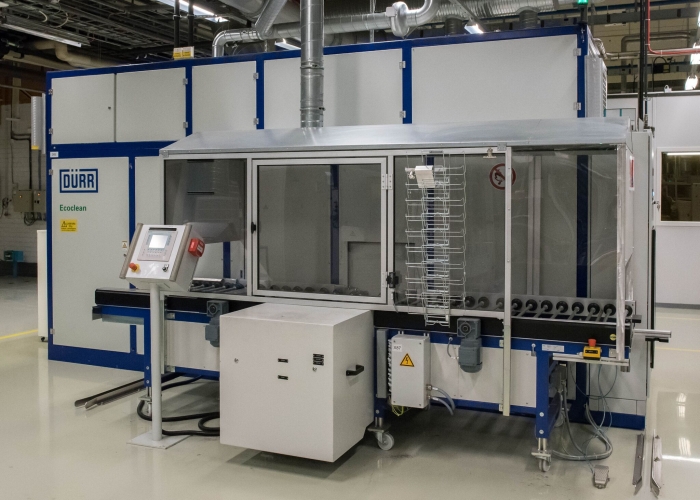
For quick and reliable degreasing of the cemented carbide and cermet indexable inserts, ranging from 5 to 50 mm in size, the hydrocarbon-based cleaning system comprises two flood tanks with separate filter circuits, and an extra 10 cm has been added to the length of its work chamber. Photos courtesy of Sandvik Coromant
Decision based on technology and design features
These criteria were also essential when the Gimo, Sweden-based company decided to replace existing cleaning equipment on its manufacturing lines and to invest in cleaning technology for an all-new product range. Environmental protection, health management and labor safety likewise played an important role. Sandvik Coromant's decision fell on three Type 71 C solvent cleaning systems by Ecoclean and one ultrasound-based ultrafine cleaning system sourced from UCM AG, a SBS Ecoclean Group company.
Anna Landström, project manager machine investments at Sandvik Coromant, explains: "The companies are well known partners throughout Sandvik Machining Solutions. What convinced us, on the one hand, was the technology and the design features of their machines. On the other hand, the systems provide many detail solutions ensuring high cleaning precision and longevity."
An additional criterion was the outcome of the cleaning tests performed in Ecoclean's and UCM's technology centers. "Especially the tests at UCM were very comprehensive as they involved various cleaning detergent suppliers and many process combinations," adds Landström.
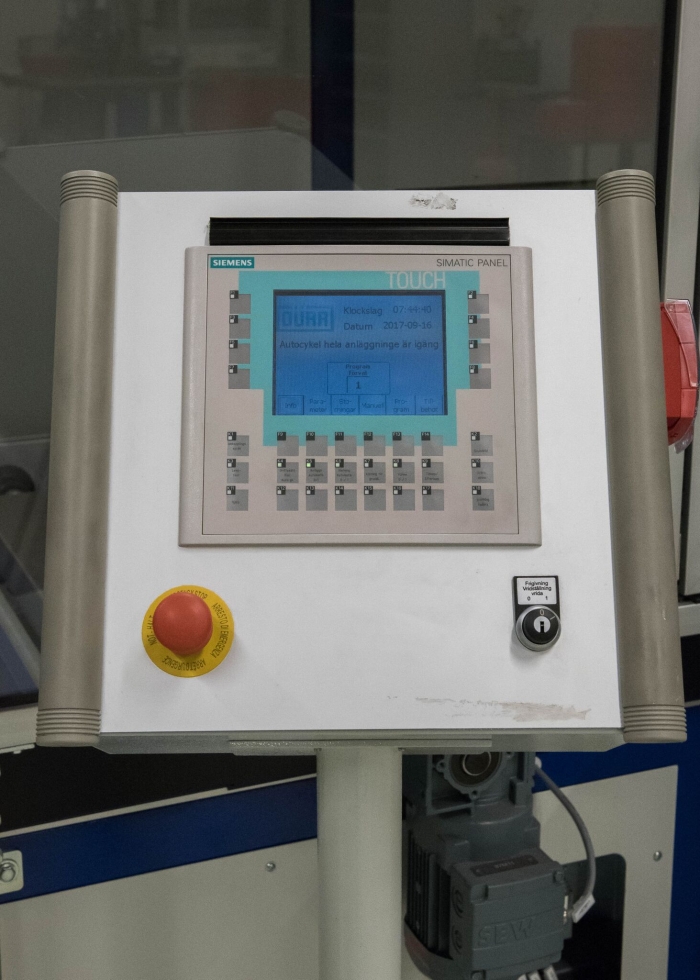
Different cleaning programs are stored in the controller of the solvent cleaning machine. Process parameters are visualized.
Quick and reliable solvent-based removal of oil residue
One of the solvent-based cleaning machines is used for cleaning cemented carbide and cermet indexable inserts, ranging from 5 to 50 mm in size, following a grinding operation with oil. "For downstream processes such as blasting, the oil residue must be removed 100 percent," explains Magnus Utberg, production engineering grinding and cleaning, identifying just one requirement. "Additional objectives were to cut cycle times and to provide optimized drying of the product."
For quick and reliable degreasing, the hydrocarbon-based cleaning system comprises two flood tanks with separate filter circuits, and an extra 10 cm has been added to the length of its work chamber. The resulting load dimensions of 770 x 480 x 300 mm (L x W x H) allows two trays filled with indexable inserts to be placed in the basket side by side and stacked on top of each. This contributes to increased throughput rates. In the work chamber the load undergoes two immersion cleaning operations with fluid from tanks Nos. 1 and 2, each with ultrasound support. This is followed by vapor degreasing. To accelerate this latter step, the vapor is directed into the work chamber straight from the distillation system. Subsequent vacuum drying ensures that all parts leave the system fully dry. "The result we achieve with this equipment is often better than anticipated," states Utberg.
The high cleaning quality is aided by effective solvent treatment. To this end, the standard main distillation system is assisted by a bypass distillation for continuous oil discharge. The filtration circuit for the No. 1 tank comprises magnetic and bag filters that retain both fine grinding particles and coarser matter. The cartridge filters integrated into the No. 2 circuit remove even very fine particles from the fluid. "We recycle the system's waste heat to heat or cool our production shop," Utberg notes.
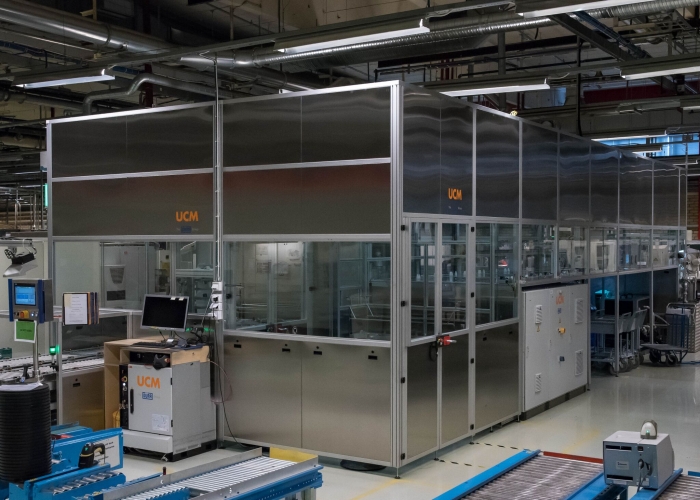
Further cleaning steps are carried out after grinding with emulsion and/or after sandblasting, and before PVD or CVD coating of the indexable inserts in the ultrasound fine cleaning system.
Ultrasound fine cleaning yields parts 'ready for coating'
Further cleaning steps are carried out after grinding with emulsion and/or after sandblasting, and before PVD or CVD coating of the indexable inserts. "From the last cleaning step, the part surface must emerge ready for coating, which means absolutely free of dirt residue, traces of corrosion, or water stains," explains David Eidenqvist, T&B grinding manager, whose department operates the UCM-designed ultrasound fine cleaning system. It comprises a total of 11 treatment stages, an automatic cleaning agent dosing system, and an oil separator. The indexable inserts are subjected to three successive ultrasound cleaning steps, each followed by rinsing with municipal water. Then two rinsing steps with demineralized water in a cascaded arrangement are carried out. The first demin-water rinsing cycle is carried out with ultrasound as well. This ensures that any surfactant or salt residue still present on the part surface will be reliably rinsed off. The four-sided overflow feature developed by UCM and the option of tilting the trays in the rack are additional technical features that contribute to high product cleanliness. After the last rinsing cycle, a blow-off station removes most of the surface moisture before the parts reach the downstream dual-stage continuous hot air drying unit.
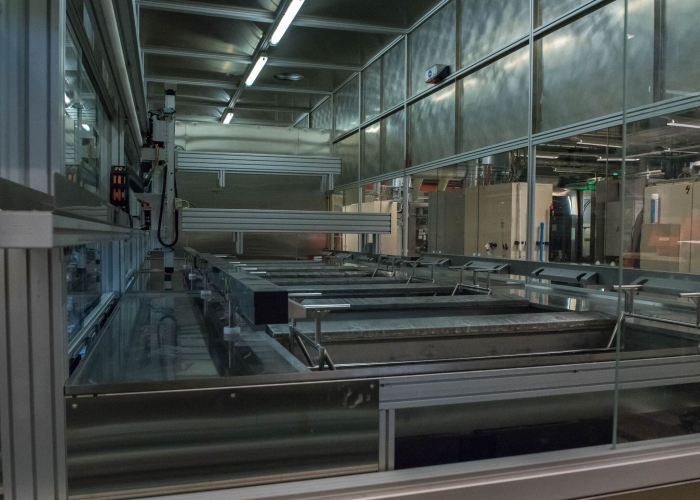
To guarantee that the surfaces of the indexable inserts are ready for coating after the last cleaning process, the system comprises 11 treatment stages.
Robotized feeding facilitates unattended operation
Exacting demands were also imposed at the level of automatic handling. "The system was expected to support unattended operation," Eidenqvist points out. To this end, it was equipped with a handling robot.
For cleaning, the indexable inserts are placed in coded trays which are then stacked. Each stack is covered with a lid and advanced by an automatic cart to the cleaning line. Here, an operator scans the bar code from the accompanying paperwork. This prompts the system to select the appropriate cleaning program. The stack is then transferred from the cart to the system's loading conveyor, which can accommodate five tray stacks at a time. The robot is equipped with a height sensor to determine the number of trays of a stack. It first removes the lid and deposits it in a lid collector. The topmost tray, which is often not fully loaded, is then temporarily stored in a waiting position until all other trays have been placed in the system's conveying racks.
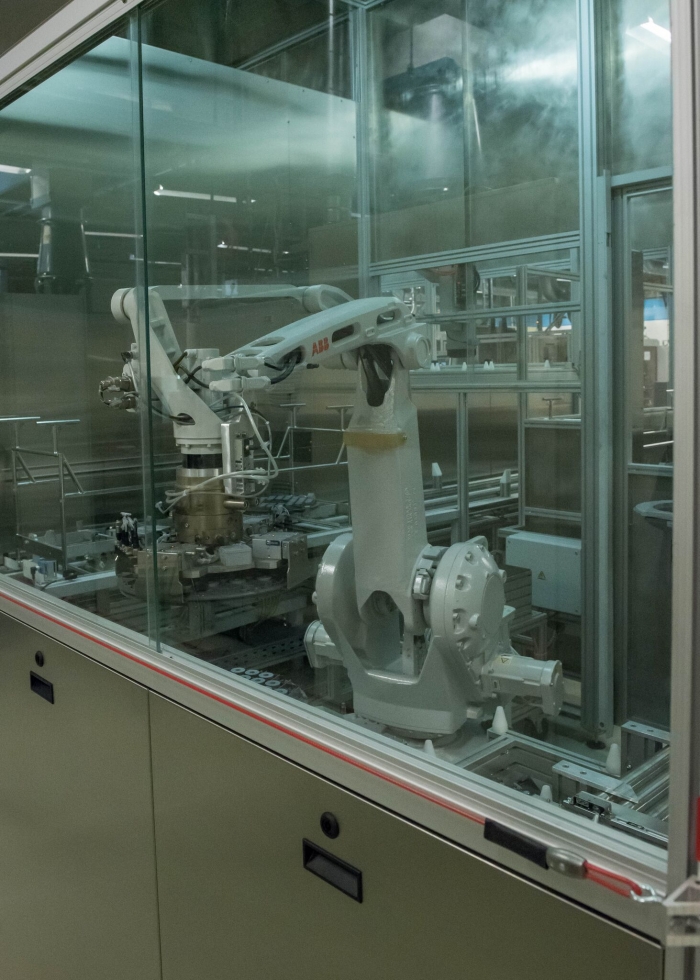
Exacting demands were also imposed at the level of automatic handling. To this end, it was equipped with a handling robot.
The loaded racks travel along the back of the system to the first treatment station from where they complete the automatically selected cleaning process toward the loading/unloading station. Upon completion of the drying step, the robot picks the trays and restacks them. To this end, the trays pass an indexing station with forked photoelectric sensor informing the robot how to place the tray on the stack so that all trays will be identically aligned.
"Apart from enhancing our cleaning results, the system reduces the input of chemicals and manpower, thus improving cost efficiency and providing better working conditions for our employees," Eidenqvist remarks.
"Moreover, the high cleanliness and good coating adhesion achieved, add that extra bit of quality to our indexable inserts, for the benefit of our customers," Landström concludes.
Related Glossary Terms
- centers
centers
Cone-shaped pins that support a workpiece by one or two ends during machining. The centers fit into holes drilled in the workpiece ends. Centers that turn with the workpiece are called “live” centers; those that do not are called “dead” centers.
- chemical vapor deposition ( CVD)
chemical vapor deposition ( CVD)
High-temperature (1,000° C or higher), atmosphere-controlled process in which a chemical reaction is induced for the purpose of depositing a coating 2µm to 12µm thick on a tool’s surface. See coated tools; PVD, physical vapor deposition.
- emulsion
emulsion
Suspension of one liquid in another, such as oil in water.
- gang cutting ( milling)
gang cutting ( milling)
Machining with several cutters mounted on a single arbor, generally for simultaneous cutting.
- grinding
grinding
Machining operation in which material is removed from the workpiece by a powered abrasive wheel, stone, belt, paste, sheet, compound, slurry, etc. Takes various forms: surface grinding (creates flat and/or squared surfaces); cylindrical grinding (for external cylindrical and tapered shapes, fillets, undercuts, etc.); centerless grinding; chamfering; thread and form grinding; tool and cutter grinding; offhand grinding; lapping and polishing (grinding with extremely fine grits to create ultrasmooth surfaces); honing; and disc grinding.
- metalworking
metalworking
Any manufacturing process in which metal is processed or machined such that the workpiece is given a new shape. Broadly defined, the term includes processes such as design and layout, heat-treating, material handling and inspection.
- milling
milling
Machining operation in which metal or other material is removed by applying power to a rotating cutter. In vertical milling, the cutting tool is mounted vertically on the spindle. In horizontal milling, the cutting tool is mounted horizontally, either directly on the spindle or on an arbor. Horizontal milling is further broken down into conventional milling, where the cutter rotates opposite the direction of feed, or “up” into the workpiece; and climb milling, where the cutter rotates in the direction of feed, or “down” into the workpiece. Milling operations include plane or surface milling, endmilling, facemilling, angle milling, form milling and profiling.
- physical vapor deposition ( PVD)
physical vapor deposition ( PVD)
Tool-coating process performed at low temperature (500° C), compared to chemical vapor deposition (1,000° C). Employs electric field to generate necessary heat for depositing coating on a tool’s surface. See CVD, chemical vapor deposition.

